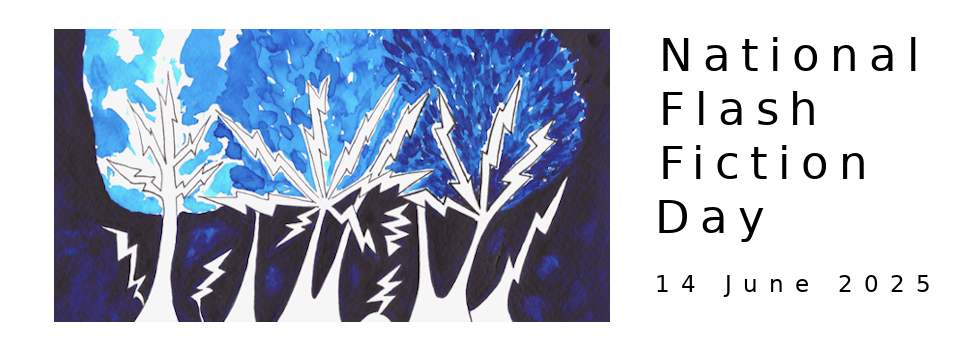Welcome to the third in our series of interviews with this year's National Flash Fiction Day Anthology editors and Microfiction Competition judges! This week, Diane Simmons chats with K.M. Elkes, one of this year's judges for the 2021 NFFD Microfiction Competition, about writing, walking, teaching, and the process of editing a collection....
Diane: National Flash Fiction Day started in 2012. Can you remember when you first heard about it? Is there a story from any of the anthologies that stays in your mind?
KM: My first encounter was in 2013. I’d not been writing long, but luckily had some early success, including winning the Fish Flash Prize and being shortlisted for the Bridport (Flash) Prize. I think this raised my profile enough to be invited by Kevlin Henney to read at a NFFD event in Bristol. The line-up included authors like Paul McVeigh, Jonathan Pinnock, Clare Reddaway, Sarah Hilary, as well as hosts Calum Kerr and Tania Hershman. It was one of my first literary/reading gigs, but it was a very welcoming atmosphere as I recall.
One of the stories that I remember from previous anthologies was Helen Rye’s title story from the 2017 anthology Sleep is a Beautiful Colour – it’s warm, tender and funny. What more do you need?
Diane: Your full flash collection All That is Between Us was published by Ad Hoc Fiction in 2019. Could you tell us a little about the process of putting the collection together?
KM: The book was an unplanned baby. Like much flash fiction, it came about as the result of a prompt - a question from Jude Higgins, of publishers Ad Hoc Fiction, who asked if I had considered publishing a flash fiction collection. The answer was, categorically, no. I thought my flash stories had very little in common, so why would anyone want to read them all together?
But after Jude’s question, I made a tentative list of stories and spotted a thread running through them, a focus on the fragility of human relationships, particularly how much we are shaped by a need to connect and belong, and how that need brings both pleasure and pain. To make the collection complete, I created about some new stories and devised a triptych structure, with the first section covering relationships between parents and children, the larger centre section concentrating on couples and the final section examining relationships between friends and strangers.
After that it was the usual effort of revisions and editing and falling in and out of love with the thing. I spent a lot of time fussing over the cover design. It was the equivalent of making sure you wear clean pants when you go out, just in case something bad happens. I wanted to ensure that even if the book fell flat and got no critical acclaim or sales, then at least it would look pretty.
Diane: I notice that as well as writing, you have been running online writing courses. Is teaching something you enjoy. Do you have plans to run more courses in the future?
KM: I started running the online courses in January 2020, as a way to encourage writers to look at their craft in less conventional ways, to take risks and really lean into their unique voice. I also enjoy the opportunity to learn more about the writing process myself and be challenged by other writers. Plus, it means I get the chance to geek out by reading and analysing great short fiction in the company of other enthusiasts. I’m not sure how much any of that could be labelled as teaching but it doesn’t really matter as long as the participants feel they have got some benefit.
The courses are part of my income but have also been an opportunity, in a small way, to help people from marginalised groups as I offer discounted places on each course. As a writer from a specifically rural working class background, I know how tricky it can be to access learning and support, so I think it is incumbent on me to do what I can to remedy this.
I’m hoping to create some longer, less intensive online courses in 2021 and, fingers crossed, get back to some face-to-face stuff too.
Diane: Writers often feel they should be tied to their desk writing. Do you find time away from your desk helpful? Is there a particular activity that helps you to come up with ideas or solve problems?
KM: Yes, I have to go do other things as being in front of a screen too long leaves me, literally, with a headache. Research has shown that walking can boost creativity. The Australian author Tegan Bennett Daylight put it best “scratch a writer and you’ll find a walker.” My courses usually feature a walking exercise when I encourage people to go for a walk with their brains creatively engaged to see what kind of weird, compelling prompts they can find.
I also need more intense physical exercise, not necessarily for mulling and thinking but just to feel part of the real world and that my body is not just an increasingly loose bag of bones and fat for my brain to stew in. So I run, cycle, play football, occasionally climb up things I shouldn’t climb up (that’s not a metaphor, I just have a potentially hazardous ‘I wonder if I could get up that’ habit). I’ve usually got quite a lot of energy to burn off, much like a dog that needs walking, though I’d like to emphasise that I am toilet-trained.
Diane: Did you write as a child or teenager? If so, can you tell us a little more about what you wrote at that time?
KM: I wrote some risible poetry as a teenager, full of hormonal angst and loiny longings. And I was always, always reading. But growing up in tiny villages in a rural county, there wasn’t much of a literary scene. It seemed a remote pursuit for posh, well-educated people. However, there was a structure in place to encourage children from lower income families to take up a musical instrument, which I got involved with. It was music that fed the creativity that eventually led to me becoming a writer. It also gave me some early craft lessons - having our ‘known arsonist’ neighbours yelling up at my bedroom while I clumsily farted my way through scales on a bassoon helped me understand concepts like tension and jeopardy.
 KM Elkes is the author of the flash fiction collection All That Is Between Us (Ad Hoc Fiction, 2019), which was shortlisted for a 2020 Saboteur Award. His flash stories have won, or been placed, in competitions including the Bath Flash Fiction Award, Reflex Fiction Prize, Fish Publishing Flash Prize and the Bridport Prize. His work featured in the Best Microfiction anthology 2020, and he has been a Best Small Fictions and Pushcart nominee. His stories have appeared in more than 40 literary anthologies and journals. He is also an award-winning short story writer and has been successful in competitions such as the Manchester Fiction Prize, the Royal Society of Literature Award and the BBC National Short Story Award. A short fiction tutor for Comma Press, he also runs flash fiction workshops online and at literary events. As an author from a rural working-class background, his work often reflects marginalised voices and places. Twitter: @kenelkes
KM Elkes is the author of the flash fiction collection All That Is Between Us (Ad Hoc Fiction, 2019), which was shortlisted for a 2020 Saboteur Award. His flash stories have won, or been placed, in competitions including the Bath Flash Fiction Award, Reflex Fiction Prize, Fish Publishing Flash Prize and the Bridport Prize. His work featured in the Best Microfiction anthology 2020, and he has been a Best Small Fictions and Pushcart nominee. His stories have appeared in more than 40 literary anthologies and journals. He is also an award-winning short story writer and has been successful in competitions such as the Manchester Fiction Prize, the Royal Society of Literature Award and the BBC National Short Story Award. A short fiction tutor for Comma Press, he also runs flash fiction workshops online and at literary events. As an author from a rural working-class background, his work often reflects marginalised voices and places. Twitter: @kenelkes
SUBMISSIONS ARE NOW OPEN for this year's National Flash Fiction Day Anthology and Micro Fiction Competition. Submissions close on 15th February 2021. For more information, please visit our Anthology and Competition guidelines.
